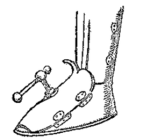Boot (torture)
The boot was an instrument of torture and interrogation designed to crush the foot and leg. The boot has taken many forms in various places and times. Common varieties include the Spanish boot and the Malay boot. One type was made of four pieces of narrow wooden board nailed together. The boards were measured to fit the victim's leg. Once the leg was enclosed, wedges would be hammered between the boards, creating pressure. The pressure would be increased until the victim confessed or lost consciousness
Spanish boot
The Spanish Boot was an iron casing for the leg and foot. Wood or iron wedges were hammered in between the casing and the victim's flesh.
Primitive forerunners of the archetype can be found dating back as far as a thousand years. The first Scottish effort-also referred to as a buskin-made use of a vaguely sock-shaped rawhide garment that was soaked with water, drawn over the foot and lower leg, and bound in place with cords. The contraption was slowly heated over a gentle fire, drastically contracting the rawhide and squeezing the foot until the bones were dislocated, though there would not have been sufficient pressure actually to crush the bones of the foot. A more progressive variant, found in both the British Isles and France, consisted of a trio of upright wooden boards that splinted around and between the feet and were tied in place by cords. Wedges were hammered between the boards and the feet to dislocate and crush the bones. A prototype hailing from Autun, France, consisted of high boots of spongy, porous leather that were drawn over the feet and legs. Boiling water was poured over the boots, eventually soaking through the leather and eating the flesh away from the entrapped limbs. Lastly, oversized boots of iron or copper (often soldered in place on the floor) received the prisoner's bare feet as he lay helplessly bound and gagged in a chair. The boots were slowly filled with boiling water or oil, or even molten lead, to consume the feet and legs. One variant-applied in Ireland, if we are to believe the legendary martyrdom of one Father Hurley-consisted of lightweight metal boots that were filled with cool water and heated (with the feet inside, of course) over a fire until the water boiled aggressively.
Foot press (Malay boot)
A similar implement, the foot press, consisted of a pair of horizontal iron plates tightened around the foot by means of a crank mechanism to lacerate the flesh and crush the bones of the foot. Although it was quite standard to line the lower plate with ribs to prevent the bare foot from slipping out of the grip of the instrument as it became sweatier, a crueler variant of this device-typically encountered in Nuremberg, Germany-lined the upper plate with hundreds of sharp spikes. A version from Venice even connected the crank mechanism to a drill, so that a hole was drilled in the center of the instep while the instrument was tightened.
This family of torture devices is not widely recorded but is described in Richard Sair's (Library of Congress cataloging under editor's name, Arnold Hirsch, M.D.) The Book of Torture and Executions (Toronto: Golden Books, 1944).
- < ISBN:B0007KECJ8 Buy it from Amazon.com >
The Malay Boot is a foot press made of wood.
Chat rooms • What links here • Copyright info • Contact information • Category:Root
